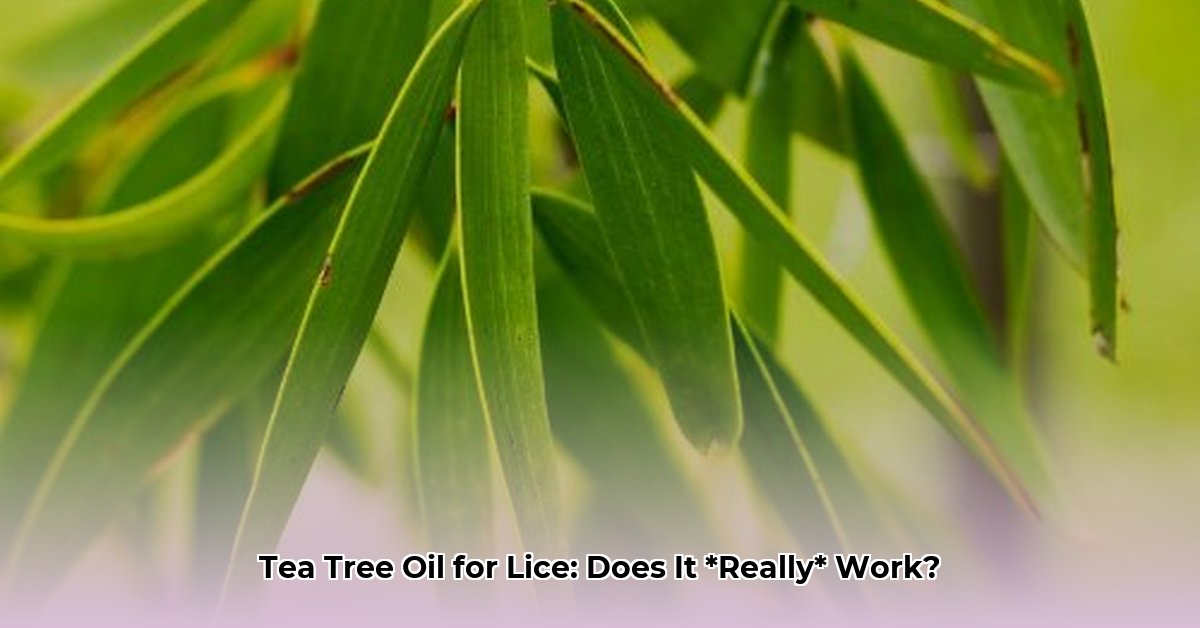So, you’re battling head lice. It’s a common, albeit frustrating, problem. Tea tree oil, with its reputation as a natural insect repellent, might seem like a promising solution. But does it actually work? Let’s delve into the evidence and separate fact from fiction.
Understanding Tea Tree Oil’s Potential
Tea tree oil, derived from the Australian tea tree (Melaleuca alternifolia), contains terpinen-4-ol, a compound with potential insecticidal and ovicidal (egg-killing) properties. This suggests it could disrupt the lice life cycle. Some studies even hint that combining tea tree oil with lavender oil might enhance its effectiveness, although more research is needed to confirm this.
Examining the Scientific Evidence
Research on tea tree oil for head lice offers a mixed bag. Some lab studies show promising results. For instance, a 2012 study found tea tree oil to be effective in killing lice at various life stages. However, lab conditions are often different from the complexities of a real-world infestation. Factors like hair thickness, oil distribution, and lice resistance can all influence the outcome. While lab studies offer clues, they don’t tell the whole story. Larger, real-world studies are necessary to fully understand tea tree oil’s effectiveness against head lice on human heads. Another earlier study published in Parasitology Research had also shown its potency against lice, but again, more comprehensive studies are needed.
A 2010 study showed that a combination of tea tree and lavender oil was comparable in effectiveness to a commercial product that works by suffocating lice. A 2007 study found tea tree oil to be the most effective repellent out of a collection of plant-based products and also DEET when used on children at a primary school.
| Study | Findings |
|---|---|
| 2012 Study | A 1% tea tree oil solution eliminated 100% of head lice in a laboratory setting within 30 minutes. It also showed some effects against louse eggs. |
| 2010 Study | A combination of tea tree and lavender oil demonstrated similar effectiveness to a commercial product that suffocates lice when used on children. |
| 2007 Study | Tea tree oil was the most effective repellent among various plant-based substances and DEET in a primary school. |
Tea Tree Oil vs. Conventional Treatments
How does tea tree oil stack up against standard over-the-counter lice treatments? Conventional treatments often contain chemicals like pyrethrins and piperonyl butoxide, which are specifically designed to kill lice. These typically boast higher success rates than tea tree oil alone. However, increasing lice resistance to these chemicals is a growing concern. This is where tea tree oil might play a role, potentially as a complementary treatment or for cases where conventional treatments fail due to resistance. Nit combing, a chemical-free method, remains highly effective but requires thoroughness and patience.
| Treatment | Potential Benefits | Potential Downsides |
|---|---|---|
| Tea Tree Oil | May kill lice and their eggs; a more natural option | Not guaranteed to eliminate all lice; possible skin irritation; limited clinical research |
| Conventional Treatments | Generally effective; readily available | Potential for chemical irritation; lice can develop resistance |
| Nit Combing | Highly effective if done thoroughly; chemical-free | Time-consuming; requires diligence |
Using Tea Tree Oil Safely (If Applicable)
If you’re considering tea tree oil, prioritize safety. Never ingest it—it’s toxic. Always dilute tea tree oil with a carrier oil (e.g., coconut, olive, or almond oil) before applying to the scalp. A patch test on your inner arm is crucial to rule out allergic reactions.
The Bottom Line: Is Tea Tree Oil a Lice Solution?
Tea tree oil might be a helpful tool in your lice-fighting arsenal, but it’s likely not a standalone solution. More research is needed to confirm its effectiveness. Thorough nit combing remains essential, regardless of the treatment you choose. While tea tree oil might offer some preventative benefits, it shouldn’t be your only strategy. Consult a healthcare professional, especially for children, pregnant women, or breastfeeding mothers, for personalized advice.
What is Tea Tree Oil and How Does It Potentially Work?
Tea tree oil, or melaleuca oil, is an essential oil distilled from the leaves of the Australian Melaleuca alternifolia tree. Its potential lice-fighting properties are attributed to compounds like 1,8-cineole and terpinen-4-ol, which are thought to disrupt the lice’s nervous system. Some research suggests that adding nerolidol might boost its effectiveness, but further investigation is needed. While some studies have shown positive results (e.g., a 1% tea tree oil solution eliminating head lice in 30 minutes in a lab setting), it’s crucial to remember that these are preliminary findings and more research, particularly in real-world settings, is essential.
How to Use Tea Tree Oil for Head Lice (Safety First!)
If you’re considering using tea tree oil for head lice, proceed with caution and consult a healthcare professional beforehand, especially for children or during pregnancy.
-
Dilute: Always dilute tea tree oil with a carrier oil (like coconut, olive, or almond oil) at a concentration of 1-5% to minimize skin irritation.
-
Apply: Gently massage the diluted mixture onto the scalp, ensuring full coverage.
-
Wait: Leave the oil on for 30 minutes to an hour.
-
Rinse: Rinse thoroughly with warm water.
-
Repeat: Repeat this process daily or every few days for two to four weeks but do not stop for a week once you have begun the treatment.
Disclaimer: This information is for educational purposes only and is not medical advice. Always consult with a healthcare professional before using tea tree oil to treat head lice, especially for children or during pregnancy or breastfeeding mothers.
- Doctor Work Life Balance: Proven Strategies for Physician Well-being - November 20, 2025
- Find Your Work-Life Harmony: Quotes for a Fulfilling Life - November 18, 2025
- CRNA Work-Life Balance: Strategies for a Healthier Lifestyle - November 16, 2025
















